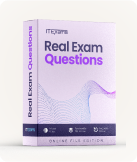Test Prep GMAT Section 2 - GMAT Section 2: Quantitative Exam
Page: 1 / 144
Total 717 questions
Question #1 (Topic: Problem-Solving Questions)
Roy is now 4 years older than Erik and half of that amount older than Iris. If in 2 years, Roy will be twice as old as Erik, then in 2 years what would be Roy’s age
multiplied by Iris’s age?
multiplied by Iris’s age?
A. 8
B. 28
C. 48
D. 50
E. 52 C
Answer: Explanation
Question #2 (Topic: Problem-Solving Questions)
An investment yields an interest payment of $228 each month. If the simple annual interest rate is 9%, what is the amount of the investment?
A. $28,300
B. $30,400
C. $31,300
D. $32,500
E. $35,100 B
Answer: Explanation
Question #3 (Topic: Problem-Solving Questions)
X, Y, Z, and W are integers. The expression X-Y-Z is even and the Expression Y-Z-W is odd. If X is even what must be true?
A. Y-Z must be odd.
B. W must be even.
C. W must be odd.
D. W must be even.
E. Z must be odd C
Answer: Explanation
Question #4 (Topic: Problem-Solving Questions)
Q is a prime number bigger than 10. What is the smallest positive number (except 1) that 3Q can be divided by equally?
A. 3 Q.
B. Q
C. 3
D. Q+3
E. 2Q C
Answer: Explanation
Question #5 (Topic: Problem-Solving Questions)
In a box there are green balls, 3A + 6 red balls and 2 yellow ones.
If there are no other colors, what is the probability of taking out a green or a yellow ball?
If there are no other colors, what is the probability of taking out a green or a yellow ball?
A. 1/5.
B. 1/2.
C. 1/3
D. 1/4.
E. 2/3. D
Answer: Explanation
